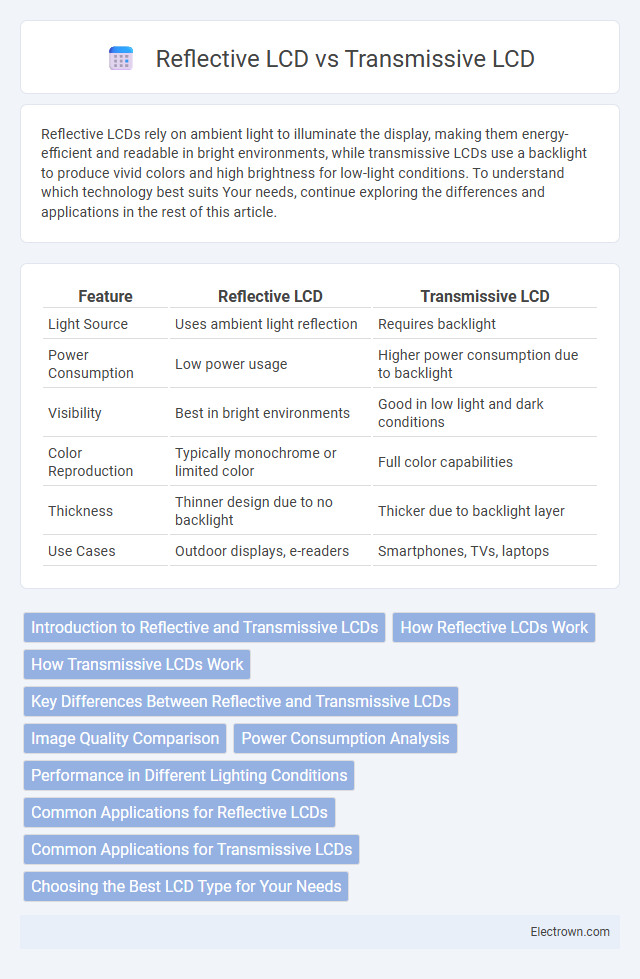Reflective LCDs rely on ambient light to illuminate the display, making them energy-efficient and readable in bright environments, while transmissive LCDs use a backlight to produce vivid colors and high brightness for low-light conditions. To understand which technology best suits Your needs, continue exploring the differences and applications in the rest of this article.
Table of Comparison
| Feature | Reflective LCD | Transmissive LCD |
|---|---|---|
| Light Source | Uses ambient light reflection | Requires backlight |
| Power Consumption | Low power usage | Higher power consumption due to backlight |
| Visibility | Best in bright environments | Good in low light and dark conditions |
| Color Reproduction | Typically monochrome or limited color | Full color capabilities |
| Thickness | Thinner design due to no backlight | Thicker due to backlight layer |
| Use Cases | Outdoor displays, e-readers | Smartphones, TVs, laptops |
Introduction to Reflective and Transmissive LCDs
Reflective LCDs use ambient light reflected from a mirror-like backing, making them highly energy-efficient and ideal for outdoor visibility. Transmissive LCDs rely on a backlight to illuminate the display, providing vibrant colors and brightness suitable for indoor use. Your choice between these LCD types depends on the viewing environment and power consumption preferences.
How Reflective LCDs Work
Reflective LCDs operate by utilizing ambient light that passes through the liquid crystal layer and reflects off a mirrored surface behind the display, eliminating the need for a backlight and significantly reducing power consumption. The liquid crystals modulate the reflected light to create visible images, making reflective LCDs ideal for devices used in bright environments, such as smartwatches and outdoor displays. This technology relies on the efficiency of the reflective layer to enhance brightness and readability under direct sunlight.
How Transmissive LCDs Work
Transmissive LCDs function by using a backlight that passes through multiple layers, including polarizers and liquid crystals, to create visible images. The liquid crystals modulate light by twisting and blocking portions of the backlight, effectively controlling color and brightness on the screen. Your display experience depends on the efficiency of this light modulation, making transmissive LCDs ideal for environments with controlled lighting.
Key Differences Between Reflective and Transmissive LCDs
Reflective LCDs use ambient light that reflects off a mirror-like backing to illuminate the display, resulting in low power consumption and excellent visibility in bright environments. Transmissive LCDs rely on a backlight that passes through the liquid crystal layer, providing vibrant colors and consistent brightness in low-light or indoor conditions. Your choice between these display types depends on usage scenarios, with reflective LCDs favored for outdoor readability and transmissive LCDs preferred for vivid image quality indoors.
Image Quality Comparison
Reflective LCDs provide better visibility in bright environments due to their use of ambient light, resulting in high contrast but limited color vibrancy. Transmissive LCDs rely on a backlight, producing more vivid colors and richer images but can suffer from glare and reduced readability in direct sunlight. Your choice between these displays depends on whether you prioritize outdoor readability or more colorful, detailed image quality indoors.
Power Consumption Analysis
Reflective LCDs consume significantly less power than transmissive LCDs by utilizing ambient light to illuminate the display instead of a backlight. Transmissive LCDs require continuous backlighting, leading to higher power consumption especially in low-light environments. This energy efficiency makes reflective LCDs ideal for battery-operated devices requiring extended usage times.
Performance in Different Lighting Conditions
Reflective LCDs excel in bright ambient lighting as they utilize external light sources to enhance display visibility, making them ideal for outdoor environments. Transmissive LCDs rely on backlighting, which provides consistent brightness in low-light or indoor settings but often suffers from glare and reduced readability under direct sunlight. Evaluating display performance across diverse lighting conditions highlights the superior outdoor usability of reflective LCDs versus the indoor versatility of transmissive LCDs.
Common Applications for Reflective LCDs
Reflective LCDs are commonly used in devices where low power consumption and readability in bright light are essential, such as digital watches, calculators, and e-readers. Their design allows ambient light to illuminate the display, making them ideal for outdoor applications and wearable technology with limited battery capacity. You will find reflective LCDs preferred in portable, energy-efficient gadgets requiring visibility without backlighting.
Common Applications for Transmissive LCDs
Transmissive LCDs are widely used in devices requiring bright, colorful displays such as smartphones, tablets, and laptops due to their ability to utilize a backlight to enhance visibility in low-light environments. These LCDs perform well in indoor and controlled lighting conditions, making them ideal for multimedia consumption, gaming, and professional workstations. Their common presence in digital cameras, handheld gaming consoles, and automotive displays underscores their versatility in applications demanding high brightness and vibrant color reproduction.
Choosing the Best LCD Type for Your Needs
Reflective LCDs provide excellent visibility in bright environments by using ambient light to illuminate the display, making them ideal for outdoor applications or low-power devices. Transmissive LCDs rely on a backlight, offering vibrant colors and brightness suited for indoor use or situations with controlled lighting conditions. Selecting the best LCD type depends on factors such as viewing environment, power consumption, and color requirements, ensuring optimal performance tailored to specific needs.
Reflective LCD vs Transmissive LCD Infographic

 electrown.com
electrown.com